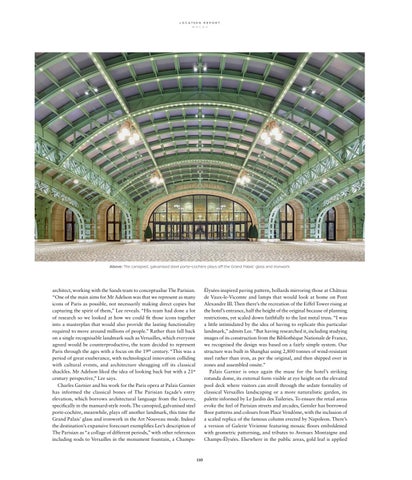Above: The canopied, galvanised steel porte-cochère plays off the Grand Palais’ glass and ironwork
Élysées-inspired paving pattern, bollards mirroring those at Château de Vaux-le-Vicomte and lamps that would look at home on Pont Alexandre III. Then there’s the recreation of the Eiffel Tower rising at the hotel’s entrance, half the height of the original because of planning restrictions, yet scaled down faithfully to the last metal truss. “I was a little intimidated by the idea of having to replicate this particular landmark,” admits Lee. “But having researched it, including studying images of its construction from the Bibliothèque Nationale de France, we recognised the design was based on a fairly simple system. Our structure was built in Shanghai using 2,800 tonnes of wind-resistant steel rather than iron, as per the original, and then shipped over in zones and assembled onsite.” Palais Garnier is once again the muse for the hotel’s striking rotunda dome, its external form visible at eye height on the elevated pool deck where visitors can stroll through the sedate formality of classical Versailles landscaping or a more naturalistic garden, its palette informed by Le Jardin des Tuileries. To ensure the retail areas evoke the feel of Parisian streets and arcades, Gensler has borrowed floor patterns and colours from Place Vendôme, with the inclusion of a scaled replica of the famous column erected by Napoleon. There’s a version of Galerie Vivienne featuring mosaic floors emboldened with geometric patterning, and tributes to Avenues Montaigne and Champs-Élysées. Elsewhere in the public areas, gold leaf is applied
architect, working with the Sands team to conceptualise The Parisian. “One of the main aims for Mr Adelson was that we represent as many icons of Paris as possible, not necessarily making direct copies but capturing the spirit of them,” Lee reveals. “His team had done a lot of research so we looked at how we could fit those icons together into a masterplan that would also provide the lasting functionality required to move around millions of people.” Rather than fall back on a single recognisable landmark such as Versailles, which everyone agreed would be counterproductive, the team decided to represent Paris through the ages with a focus on the 19th century. “This was a period of great exuberance, with technological innovation colliding with cultural events, and architecture shrugging off its classical shackles. Mr Adelson liked the idea of looking back but with a 21st century perspective,” Lee says. Charles Garnier and his work for the Paris opera at Palais Garnier has informed the classical bones of The Parisian façade’s entry elevation, which borrows architectural language from the Louvre, specifically in the mansard-style roofs. The canopied, galvanised steel porte-cochère, meanwhile, plays off another landmark, this time the Grand Palais’ glass and ironwork in the Art Nouveau mode. Indeed the destination’s expansive forecourt exemplifies Lee’s description of The Parisian as “a collage of different periods,” with other references including nods to Versailles in the monument fountain, a Champs-
110
